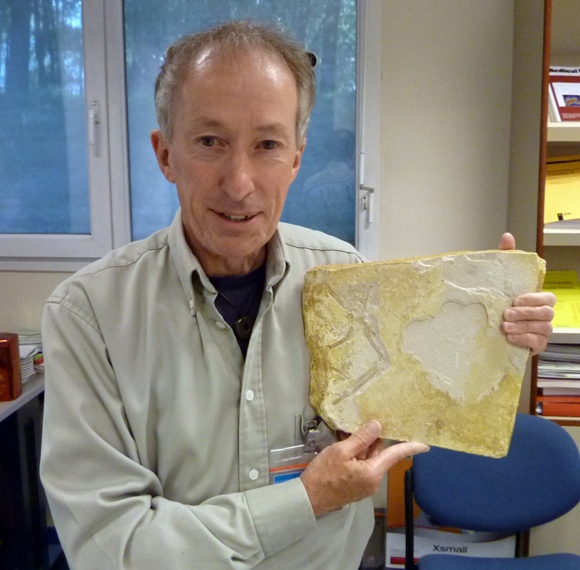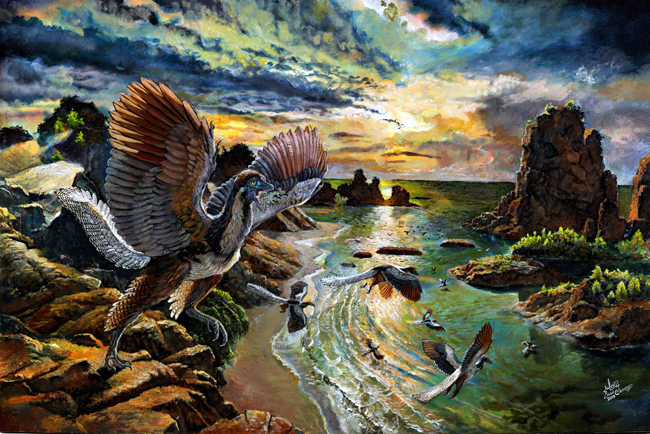Archaeopteryx albersdoerferi – A New Species of Archaeopteryx is Named
Those very rare Archaeopteryx specimens that have been found in the fine-grained, Upper Jurassic deposits of Germany are some of the most intensely researched fossils on our planet. However, they can still surprise and it seems that we have much to learn about “Urvogel” as the Germans refer to this iconic transitional form between a dinosaur and a true bird.
Writing in the academic journal “Historical Biology”, a team of international researchers have subjected one particular fossil (specimen number eight), to the powerful X-rays of synchrotron microtomography and discovered that this example of the “first bird” is so different from other Archaeopteryx fossils that it merits being categorised as a separate species.
A Life Reconstruction of the Newly Described Archaeopteryx Species (A. albersdoerferi)
Picture credit: Zhao Chuang (supervised by lead author of the scientific paper Martin Kundrát of Uppsala University)
Closer to True Birds in Evolutionary Terms
The scientists, which included researchers from Uppsala University, the Chinese Academy of Geological Sciences and Manchester University’s John Nudds (School of Earth and Environmental Sciences), carried out a three-dimensional analysis of the fossil using the European Synchrotron Radiation Facility (ESRF), located in Grenoble. The team found that specimen eight is closer to modern birds in evolutionary terms when compared to the other known Archaeopteryx specimens.
Dr Nudds explained:
“By digitally dissecting the fossil we found that this specimen differed from all of the others. It possessed skeletal adaptations which would have resulted in much more efficient flight. In a nutshell, we have discovered what Archaeopteryx lithographica evolved into – i.e. a more advanced bird, better adapted to flying – and we have described this as a new species of Archaeopteryx.”
Dr John Nudds with the Archaeopteryx Specimen at the Synchrotron Facility

Picture credit: Manchester University
Differences in the Skeleton – Better Adaptations for Powered Flight
The research team identified numerous, subtle skeletal differences between this specimen and the other Archaeopteryx fossil skeletons. For example, specimen eight has fused cranial bones, a different pectoral girdle and wing elements and a more robust set of carpals and metacarpals (hand bones). The X-ray scans revealed that this specimen had very light bones, with numerous air sacs in them. These characteristics are observed more in modern flying (volant), birds and are not found in the older Archaeopteryx lithographica species.
The fossil studied is the so-called Mörnsheim or Daiting specimen, from strata which is around half a million years younger than the rocks associated with the majority of the German Archaeopteryx fossils. As such, specimen eight is stratigraphically the youngest Bavarian archaeopterygid.
Archaeopteryx albersdoerferi – “The Phantom”
The Mörnsheim or Daiting fossil has had a colourful history. It was (allegedly), discovered by a private fossil collector in a quarry near the town of Daiting in southern Bavaria, about twenty miles south of the city of Nuremberg (Germany), sometime in the early 1990s. It was incorrectly identified as a pterosaur and this fossil changed hands several times. Rumours began to circulate amongst the scientific community that there was another Archaeopteryx specimen but it remained elusive, so much so, that the fossil was nick-named “The Phantom”. A cast of the fossil was briefly put on display at the Naturkundemuseum in Bamberg (Germany) in 1996 and a short report was written a year later, but this specimen remained out of reach and not accessible for study.
All this changed in 2009, when palaeontologist Raimund Albersdörfer of Schnaittach (Bavaria), purchased the specimen from a private collector and secured its scientific heritage by offering it on long-term loan to the Bavarian State Collection of Palaeontology and Geology in Munich, and obligated himself by contract not to sell the specimen to a non-public entity. The species name honours the contribution made by Raimund Albersdörfer. This is not the first time that Raimund has made a privately-owned Theropod specimen available to study. In 2012, he was honoured by having the trivial name of a feathered dinosaur from southern Germany named after him (Sciurumimus albersdoerferi).
Lead author, Dr Martin Kundrát, commented:
“This is the first time that numerous bones and teeth of Archaeopteryx were viewed from all aspects including exposure of their inner structure. The use of synchrotron microtomography was the only way to study the specimen as it is heavily compressed with many fragmented bones partly or completely hidden in limestone.”
Is This Really a New Species?
Palaeontologists are aware that this part of Germany where the Archaeopteryx fossil material comes from, was once a series of small islands surrounded by a tropical sea. The strata were laid down over hundreds of thousands of years and it is therefore quite possible that different species of primitive “dino-bird” evolved over this period. However, the Mörnsheim specimen was examined using computer tomography that provided an extremely detailed assessment of the fossil material. It is quite possible, that, if other Archaeopteryx specimens were subjected to the same level of scrutiny, then new information about them would be discovered too.
To read an article from 2016, that reports on the discovery of a twelfth Archaeopteryx specimen, a fossil recovered from strata at least 200,000 years older than other Archaeopteryx fossil material: The Oldest Archaeopteryx in Town.
The scientific paper: “The First Specimen of Archaeopteryx from the Upper Jurassic Mörnsheim Formation of Germany” by Martin Kundrát, John Nudds, Benjamin P. Kear, Junchang Lü and Per Ahlberg published in Historical Biology.
Everything Dinosaur acknowledges the help of a press release from the University of Manchester in the compilation of this article.
Visit the Everything Dinosaur website: Everything Dinosaur.







Leave A Comment